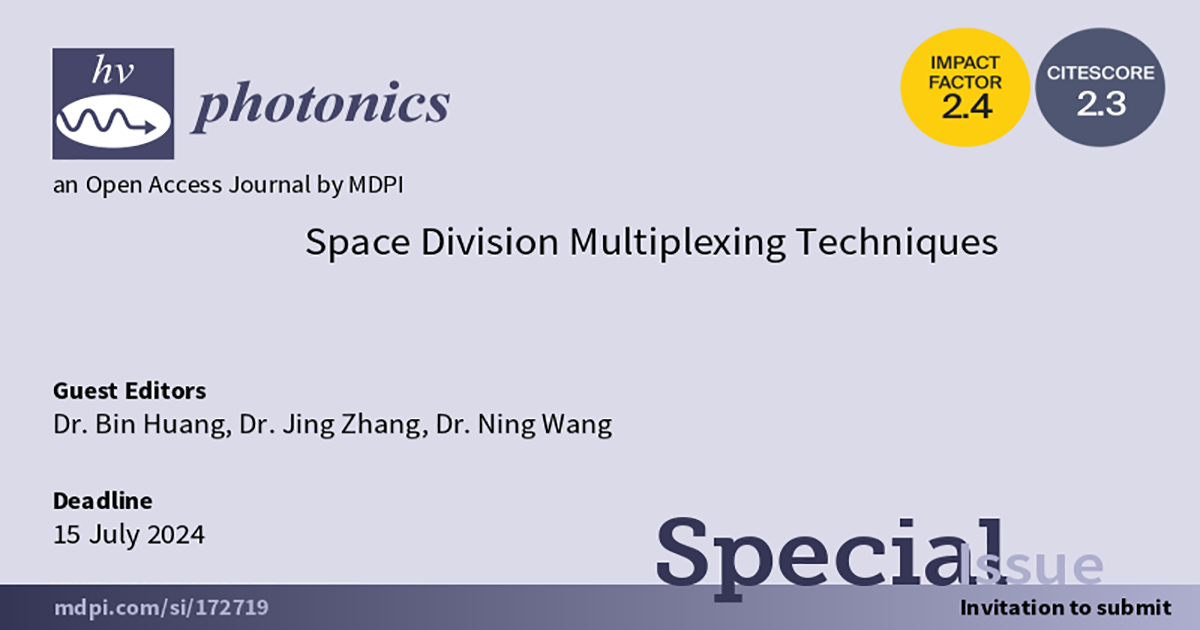Space Division Multiplexing Techniques
A special issue of Photonics (ISSN 2304-6732).
Deadline for manuscript submissions: 15 July 2024 | Viewed by 1790

Special Issue Editors
Interests: optical device; photonics; fiber communication
Interests: integrated optical theory and technology
Special Issue Information
Dear Colleagues,
Optical fiber communication is the backbone of the telecommunications infrastructure that supports the internet. As internet demand keeps on increasing, the need for a single fiber to carry more information is crucial. It is very important to find smart solutions to increase the capacity x times in a single fiber by increasing the cost much less than x times. Space division multiplexing (SDM) is viewed to be the most promising solution to meet this criterion. SDM techniques can be categorized as multi-mode fiber (MMF)/few-mode fiber (FMF) transmission, uncoupled-core multi-core fiber (MCF) transmission and coupled-core MCF transmission. Great efforts have been made for the improvement of SDM techniques, which includes SDM multiplexers, SDM amplifiers, SDM fibers, SDM signal processing, etc.
Long-haul laboratory transmission experiments have long been verified; however, further improvements are needed for SDM techniques to be feasible for industrial applications (e.g., high-performance devices (coupler, multiplexer, amplifier, switch, etc.), high-quality SDM fibers, stronger nonlinear property advantages than SMF, less signal processing complexity, and so on). In addition, SDM techniques could potentially find applications in some other fields. In distributed fiber sensing applications, SDM techniques can be applied to detect vibration locations over long distances.
We encourage researchers to further explore SDM techniques to make it feasible in industrial techniques. We also encourage new applications of SDM techniques. We encourage researchers to explore issues including, but not limited to:
- SDM transmission system, including MMF/FMF, uncoupled-core MCF, coupled-core MCF transmission;
- High-performance SDM devices, including multiplexer, coupler, amplifier, switch, etc.;
- SDM transmitter and receiver system design;
- SDM transmission signal processing algorithm and complexity;
- SDM transmission nonlinearity research;
- SDM technique applications in fiber sensing and other fields.
Dr. Bin Huang
Dr. Jing Zhang
Dr. Ning Wang
Guest Editors
Manuscript Submission Information
Manuscripts should be submitted online at www.mdpi.com by registering and logging in to this website. Once you are registered, click here to go to the submission form. Manuscripts can be submitted until the deadline. All submissions that pass pre-check are peer-reviewed. Accepted papers will be published continuously in the journal (as soon as accepted) and will be listed together on the special issue website. Research articles, review articles as well as short communications are invited. For planned papers, a title and short abstract (about 100 words) can be sent to the Editorial Office for announcement on this website.
Submitted manuscripts should not have been published previously, nor be under consideration for publication elsewhere (except conference proceedings papers). All manuscripts are thoroughly refereed through a single-blind peer-review process. A guide for authors and other relevant information for submission of manuscripts is available on the Instructions for Authors page. Photonics is an international peer-reviewed open access monthly journal published by MDPI.
Please visit the Instructions for Authors page before submitting a manuscript. The Article Processing Charge (APC) for publication in this open access journal is 2400 CHF (Swiss Francs). Submitted papers should be well formatted and use good English. Authors may use MDPI's English editing service prior to publication or during author revisions.
Keywords
- space division multiplexing
- few-mode fiber
- multimode fiber
- multi-core fiber
- fiber-based device
- amplifiers
- nonlinearity





